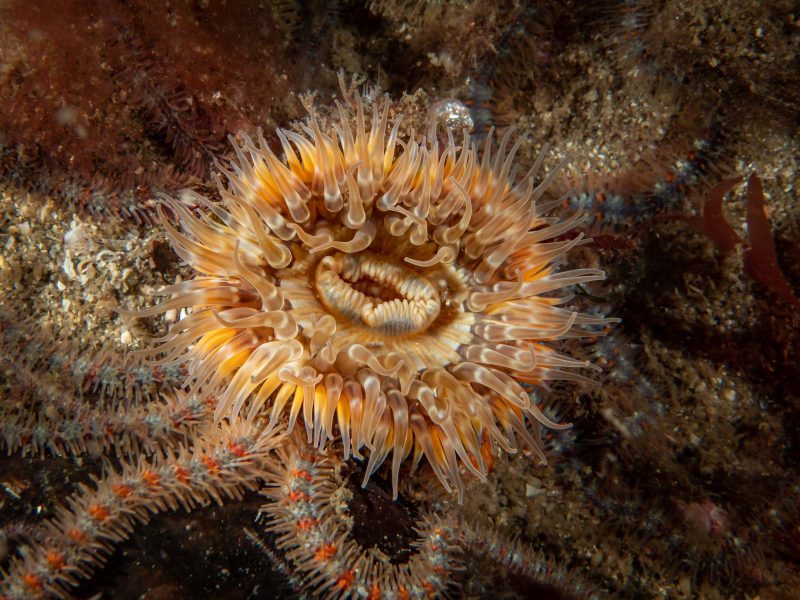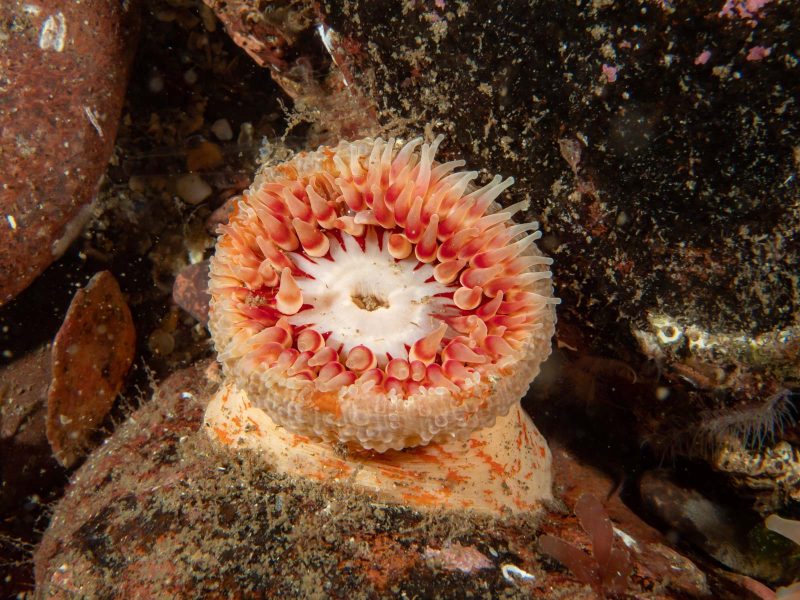Stunning Photographs of Rare Wolffish You Won’t Believe Exist!
When I started diving in Scotland, it opened my eyes to a whole host of marine life I had no idea we had, or in some cases, even existed… and one particular creature that fits the latter is the Atlantic wolffish! I’d heard others talking about these odd creatures in passing over the years, but it wasn’t until I spotted a post from a fellow photographer about running a “Wolfie Workshop” that I really took any notice. A quick Google search later, and I was scrambling to get booked on. Now, as I always admit, I’m no expert in marine biology. For a long time, my “expertise” extended to “It’s a fish,” and for a while, my attitude was very much, “I just take the photo and let others do the identifying.” However, over the last few years, I’ve tried to expand my knowledge, and where better to start than with these unique fish? The Berwickshire Marine Reserve, where wolffish can be found, spans the coastline from just north of the small fishing village of St Abbs (or New Asgard if you’re from the Marvel Universe) to Eyemouth. It was set up by volunteers in 1984 with the aim to conserve the biodiversity of the coastal waters, raise awareness of the marine environment through education and research, and promote responsible recreational use alongside sustainable fishery for the mutual benefit of all. From my personal experience diving around St Abbs, the reserve certainly seems to be working. The seabed is breathtaking – the abundance and diversity of life are just incredible. It’s such an impressive area, spanning 8km of the coastline, reaching depths of 50m, and covering an area of around 10km². Ranging from the tiny nudibranch to grey seals and bottlenose dolphins, this stretch of Scotland’s coastline is a diver’s paradise. It’s also a testament to the hard work done by local volunteers to protect this incredible ecosystem. Atlantic wolffish can grow up to 5ft in length and feed on bottom-dwelling life like crabs, lobsters, sea urchins, and starfish. They use their vicious-looking front teeth (which give them their name) to break through the hard shells to the soft meat beneath. They grow a new set of teeth every year, with the new set growing from behind the old. They often prefer depths ranging from 60m to 300m, so finding them around 10/15m off the coast of St Abbs suits me just fine! Prefering rocky seabeds, wolffish often choose to make their homes in cracks and crevices. Although generally seen as solitary fish, it’s not uncommon to find several in a suitable area, and even from time to time, two in one crack. However, if there’s ever a reason not to go poking around the seabed, the fangs on the wolffish are it! They’re not naturally aggressive towards humans, but they look pretty intimidating and have been known to snap if feeling threatened. When finding wolffish, using local knowledge is key. The 10km² that make up the St Abbs diving area is a big patch to search in. With limited time underwater, it helps to know both where to look and the signs to look for. Thankfully, with the help of some incredible guides, I learned what to look for. In some areas, the seafloor looks like a carpet of brittle stars, and being one of the wolffish’s favourite meals, it’s the perfect place to start the search. But with vast areas covered in these brittle stars, this can still take a while. The trick is to look out for parts of the seabed that are free of these stars. That generally suggests the wolffish are hiding in a crack nearby and have already hoovered up the brittle stars around their home. According to guides, during winter, it’s thought that these wolffish head for deeper waters, where the females will lay their eggs on the seafloor. They then return to the same caves and crevices in these shallower waters year after year. So much so that some of the regular divers claim to have struck up friendships of sorts with a few of the wolffish, who will often come out to say hello. Wolffish are not the most photographed fish in the sea, and let’s be honest, they aren’t exactly the prettiest inhabitants either. But that doesn’t mean they don’t have their part to play in the ecosystem. Atlantic wolffish play a crucial role in their environment because of their unique diet. They regulate the population size of prey species like sea urchins and green crabs, which, if left unchecked, could have dramatic ramifications on their ecosystem. Sadly, in 2004, the U.S. Marine Fisheries Service placed these unique fish on a list of Species of Concern after witnessing their numbers rapidly decline, mainly due to accidental fishing (bycatch) and trawling. They might not be as pretty as some of their seabed neighbours, and they don’t have the cute factor that many other endangered species have, but these incredible creatures still need our protection. Photography has always been a powerful medium for raising awareness and storytelling. By capturing evocative imagery of

When I started diving in Scotland, it opened my eyes to a whole host of marine life I had no idea we had, or in some cases, even existed… and one particular creature that fits the latter is the Atlantic wolffish!
I’d heard others talking about these odd creatures in passing over the years, but it wasn’t until I spotted a post from a fellow photographer about running a “Wolfie Workshop” that I really took any notice.

Now, as I always admit, I’m no expert in marine biology. For a long time, my “expertise” extended to “It’s a fish,” and for a while, my attitude was very much, “I just take the photo and let others do the identifying.”
However, over the last few years, I’ve tried to expand my knowledge, and where better to start than with these unique fish?
The Berwickshire Marine Reserve, where wolffish can be found, spans the coastline from just north of the small fishing village of St Abbs (or New Asgard if you’re from the Marvel Universe) to Eyemouth.
It was set up by volunteers in 1984 with the aim to conserve the biodiversity of the coastal waters, raise awareness of the marine environment through education and research, and promote responsible recreational use alongside sustainable fishery for the mutual benefit of all.

From my personal experience diving around St Abbs, the reserve certainly seems to be working. The seabed is breathtaking – the abundance and diversity of life are just incredible.
It’s such an impressive area, spanning 8km of the coastline, reaching depths of 50m, and covering an area of around 10km².

Ranging from the tiny nudibranch to grey seals and bottlenose dolphins, this stretch of Scotland’s coastline is a diver’s paradise. It’s also a testament to the hard work done by local volunteers to protect this incredible ecosystem.
Atlantic wolffish can grow up to 5ft in length and feed on bottom-dwelling life like crabs, lobsters, sea urchins, and starfish.

They use their vicious-looking front teeth (which give them their name) to break through the hard shells to the soft meat beneath. They grow a new set of teeth every year, with the new set growing from behind the old.
They often prefer depths ranging from 60m to 300m, so finding them around 10/15m off the coast of St Abbs suits me just fine!
Prefering rocky seabeds, wolffish often choose to make their homes in cracks and crevices. Although generally seen as solitary fish, it’s not uncommon to find several in a suitable area, and even from time to time, two in one crack.

However, if there’s ever a reason not to go poking around the seabed, the fangs on the wolffish are it! They’re not naturally aggressive towards humans, but they look pretty intimidating and have been known to snap if feeling threatened.
When finding wolffish, using local knowledge is key. The 10km² that make up the St Abbs diving area is a big patch to search in. With limited time underwater, it helps to know both where to look and the signs to look for.

Thankfully, with the help of some incredible guides, I learned what to look for.
In some areas, the seafloor looks like a carpet of brittle stars, and being one of the wolffish’s favourite meals, it’s the perfect place to start the search. But with vast areas covered in these brittle stars, this can still take a while.
The trick is to look out for parts of the seabed that are free of these stars. That generally suggests the wolffish are hiding in a crack nearby and have already hoovered up the brittle stars around their home.
According to guides, during winter, it’s thought that these wolffish head for deeper waters, where the females will lay their eggs on the seafloor. They then return to the same caves and crevices in these shallower waters year after year.

So much so that some of the regular divers claim to have struck up friendships of sorts with a few of the wolffish, who will often come out to say hello.
Wolffish are not the most photographed fish in the sea, and let’s be honest, they aren’t exactly the prettiest inhabitants either. But that doesn’t mean they don’t have their part to play in the ecosystem.
Atlantic wolffish play a crucial role in their environment because of their unique diet. They regulate the population size of prey species like sea urchins and green crabs, which, if left unchecked, could have dramatic ramifications on their ecosystem.
Sadly, in 2004, the U.S. Marine Fisheries Service placed these unique fish on a list of Species of Concern after witnessing their numbers rapidly decline, mainly due to accidental fishing (bycatch) and trawling.

They might not be as pretty as some of their seabed neighbours, and they don’t have the cute factor that many other endangered species have, but these incredible creatures still need our protection.
Photography has always been a powerful medium for raising awareness and storytelling.
By capturing evocative imagery of wolffish in their natural environments and sharing stories of playful friendships and encounters, we can help raise awareness about this fascinating species and their increasingly dwindling numbers.

Although the wolffish were clearly the main attraction during these dives, the other underwater wildlife was just as eye-catching.
The seabed in the area is a cacophony of colour, with many dahlia anemones to be seen, and lobsters often found nonchalantly wandering across the sand.
In fact, during one of my dives, my buddy and I stopped pointing them out to each other – not something that happens often.

I don’t think my camera knew what had hit it, and by the end of two days of diving, the memory card was bursting full of images!
In my nearly seven years of diving, I’ve seen some incredible things here in Scotland. Things as I say, I didn’t know we had, creatures I was completely oblivious to.
But wolffish are probably the ones that stand out most and are one my favourite highlights so far.







